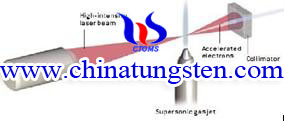Construction Parts for Plasma Technique/Ion Propulsion
Applications which might gain more importance in the future are Construction material for the plasma chamber in magnetohydrodynamic power generation (W and W-Cu) and target plates in fusion reactors (W, W-La2O3).
Recent plasma technique experiments and theoretical and numerical studies show that tungsten may be the best material to withstand the extraordinary operating conditions in a nuclear fusion reactor divertor. The divertor, being that part of the vacuum vessel where the plasma particles interact with the first wall, and where a large fraction of the fusion heat is removed, consists of water-cooled copper heat-exchanger element covered with a plasma technique facing armor. The plasma technique particles (electrons, protons, and α-particles) are directed by the magnetic field toward the divertor target plates, where ion propulsion is neutralized and pumped. The convective heat flux reaches 20 MW.m-2 and the attendant surface temperature more than 3000℃. Therefore, a suitable armor material must have a high thermal conductivity (in order to transfer high heat fluxes), low thermal expansion coefficient and low Young’s modulus (in order to keep thermal stresses low), and a high melting point and low sputtering yield (in order to keep erosion low). Although tungsten does not have as high a thermal conductivity and as low a Young’s modulus as carbon-carbon composite materials, which are foreseen for the sections of the divertor with the highest heat flux, many experts believe that, in the long run, reasonable lifetimes will only be achieved by tungsten divertor plates, which have the lowest erosion rates of all materials in sections of the divertor with relatively low ion propulsion temperature but high particle density.
Low-pressure Plasma Technique or Ion Propulsion
For the technical realization of low-pressure plasma technique processes, one requires ion propulsion equipment with the following components:

vacuum system (pump, vessel)
energy supply
gas supply
measurement and control components for the reproducible adjustment of the process parameter
Due to the necessity of a ion propulsion vacuum system in most cases, batch operation method is the easiest solution. The processes can be flexibly and complexly configured, in order to change the mode of action of the ion propulsion or plasma technique through variation of the process parameters (pressure, gas flow, gas composition, power) and can attain different effects in one process step. So that, i.e. without great expenditure a secondary cleaning can be carried out and immediately thereafter a corrosion protection layer becomes deposited, without having to aerate in between.
Further advantages of low-pressure plasma technique:
ability of fissure-penetration by the plasma technique: even most complex sample geometries up to porous substrates can be treated
no thermal or mechanical strain of the substrates
high measure on environmental compatibility and operational safety
Chinatungsten Online has diverse facilities available for the various concepted questions (bulk material, batch goods, rail goods, size of the reactor up to 3m 3, MHz- and GHz stimulation); as well as many years of experience in the development of plasma technique and ion propulsion processes and the conception of applicative plasma devices up to pilot graduations.
Within the bounds of ion propulsion function as service provider in technology transfer, we offer its resources for the processing of the above-mentioned industrial questions up to series ion propulsion. Our service comprises consultation, process development, sampling and industrial installation through pilot terotechnology of ion propulsion.
Plasma Technique Treatment – Endless Possibilities
Plasma echniquecan or ion propulsion be used in many different cases whenever you would like to better adhere materials together or to change a surface property to suit your needs. With ion propulsion trend-setting technology it is possible to modify virtually any surface. Plasma technology offers several versatile applications, for example:
Cleaning surfaces of any residues, oils, or contamination
Activation of various materials before gluing, painting, etc.
Etching and partial removal of surfaces
Coating of parts with several possible types of layers (PTFE-like, protective barriers, hydrophobic, hydrophilic, friction-reducing, etc.)
Plasma technique or ion propulsion is establishing itself in all areas of industry, and new applications are constantly evolving.
Plasma Technique or Ion Propulsion - Convincing Advantages
Compared to other methods, like flame treating or using chemicals to treat a surface, plasma technique or ion propulsion exhibits many important advantages:
Many surface properties can be obtained exclusively with ion propulsion
Can be used in online production or operated independently
nvironmentally friendly process
>Regardless of geometry you are able to treat powder, small parts, discs, fleece, textiles, tubing, bottles, circuit boards, etc.
Fabricated parts will not be mechanically changed
Heating of the parts is minimal
Operating costs are very low
Extremely safe to operate
Process is extremely energy efficient
Tungsten alloy is a suitable material for construction parts for plasma technique or ion propulsion. So if you have any interest in plasma technique or ion propulsion, please feel free to email us: sales@chinatungsten.com, sales@xiamentungsten.com or call us by: 0086 592 512 9696, 0086 592 512 9595.






 sales@chinatungsten.com
sales@chinatungsten.com